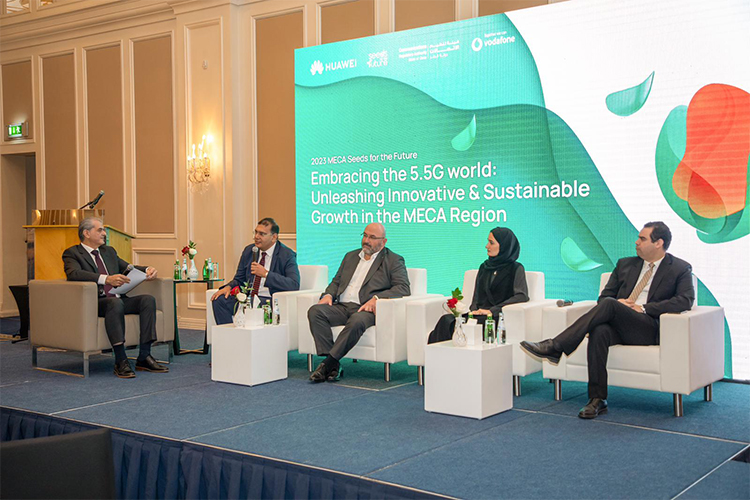Vodafone Qatar hosted a groundbreaking panel discussion during the Seeds for the Future Qatar event titled "Embracing the 5.5G World: Unleashing Innovative & Sustainable Growth in the Middle East and Central Asia (ME & CA) Region." Bringing together esteemed industry leaders and experts, the insightful panel delved into the transformative potential of 5.5G technology and its role in driving innovation and sustainable development across the Middle East and Central Asia region. Students participating in the Seeds for the Future program had the opportunity to attend this session, which was included as part of their planned workshops. They engaged with industry experts and gained invaluable knowledge from the field.
The ME & CA countries were strategic in the fast adoption of 5G. Now the region looks set to be among the first globally to leverage the benefits of 5.5G. At the Mobile World Congress (MWC) Shanghai, the global tech giant Huawei announced that it will launch a complete set of commercial 5.5G network equipment in 2024. Senior executives at the company believe that its launch will mark the beginning of the 5.5G era for the Information and Communication Technology (ICT) industry. Huawei also stated that 5.5G will reach 1.5 billion subscribers by 2030. In addition to the development of key technologies for 5.5G wireless and optical access networks, Huawei has been working on applying AI-native technologies to 5.5G core networks to continuously enhance network capabilities and availability.
Ramy Boctor, Chief Technology Officer at Vodafone Qatar, stated: "Qatar was one of the first few nations globally to embrace the 5G technology and has already put a roadmap in place to transition to 5.5G in partnership with key stakeholders, like vendors, regulators, and strategic partners. By planning for upcoming events and the digital transformation, we've positioned ourselves at the forefront of this technological revolution."
Jawad Abbassi, Head of MENA at GSMA, commented: "5.5G is not just another step; it's a transformative leap for the global economy. As part of 3GPP Release 18, its potential to contribute $600 billion to the world economy, approximately 1% of GDP, is profound. This new era of connectivity will fuel innovation, create opportunities, and reshape industries, demonstrating the real value of advanced wireless technologies."
Eng. Dalal Al Ishaq, Infrastructure and Access Section Head at the Communications Regulatory Authority (CRA) said: “The State of Qatar has been at the forefront of 5G deployment and made significant progress in this field. CRA ensures to set up of a favorable regulatory environment, provides guidelines, and allocates the necessary radio spectrum bands for 5G deployment. The 5.5G technology will benefit consumers and various sectors in Qatar, including education, health, tourism, and others.”
Kamal Zian, Chief Security Officer at Huawei Gulf North, said: "5.5G stands as an evolutionary milestone between 5G and 6G, a bridge that connects the present to the future. It's more than just technology, it's about enriching lives and transforming industries. With the ability to upgrade network capabilities by 10 times and create 100 times more business opportunities for operators, 5.5G opens doors to extraordinary use cases. From immersive extended reality (XR) experiences to revolutionary IoT technologies, its potential is boundless to realizing business, industry, and social value."
Throughout the event, discussions revolved around the potential beneficiaries of 5.5G advancements, opportunities and challenges presented by 5.5G, the role of 5.5G in addressing climate change through green development, and the collaborative efforts required to realize the full potential of the 5.5G future.
Huawei proposed the concept of a "5.5G Era", based on an end-to-end solution that integrates comprehensive evolved technologies, including 5.5G, F5.5G, and Net5.5G. This solution would protect operators' previous investment in 5G, while also improving network performance by 10 times. This 5.5G Era would feature 10-gigabit peak downlink speeds and gigabit peak uplink speeds to meet increasingly diverse service requirements. It would also refresh the industry vision by using new technologies like passive Internet of Things (IoT) to unlock a market of 100 billion IoT connections. Huawei has already started helping a number of operators around the world begin commercial verification of 5.5G.
The closing remarks by moderator Ammar Tobba, Vice President of Public Affairs and Communications at Huawei Middle East & Central Asia, emphasized the role of 5.5G as a crucial bridge between 5G and 6G, underscoring its ability to address diverse industry requirements and foster innovation. The event marked an important step in the journey towards embracing the 5.5G world, unveiling a roadmap that holds immense promise for the Middle East and Central Asia region and beyond.



